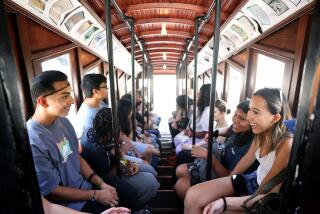The assignment: Design a poster that dispels America’s myths about immigrants
- Share via
If you played Chutes and Ladders as a kid, you probably recall the frustration: There you are, just a few squares away from winning it all, when the wrong roll of the dice sends you sliding back to last place.
For ArtCenter College of Design student Nico Abbassi, that game was an apt metaphor for the often infuriatingly complex American immigration process.
“My parents immigrated from Iran, and when I was growing up, my grandma was trying to immigrate,” Abbassi said. “I was a kid and I didn’t really understand all they were going through for years and years just to get a green card. I had no idea about all the legal stuff and fees involved. … I had no idea just how difficult it could be.”
To convey some immigrants’ frustration of getting ahead only to fall back, Abbassi designed a poster — a children’s board game with squares that read “daca,” “asylum,” “work visa” and “fees.” The message: Let’s have greater compassion for immigrants and refugees doing their best to navigate what can seem like an impossible system.
Abbassi was one of six students enrolled in ArtCenter’s Smart Image + Social Impact course, which recently unveiled poster designs aimed at dispelling common myths about immigrants.
Each fall, students in the course are paired with a local nonprofit organization. This year, they worked with United We Stay, an online platform committed to generating empathy and fact-based dialogue about immigration.
United We Stay founder Marcelino J. Miyares presented students with a series of common beliefs surrounding immigration, such as “immigrants won’t get in line” (Abbassi’s subject), “immigrants take Americans’ jobs,” “immigrants drain America’s social services programs” and “immigrants are criminals.” The students were asked to research the subjects on their own before developing the design ideas they presented to Miyares and his team.
ArtCenter instructor Esther Pearl Watson says the partnership provided students with the chance to develop critical thinking skills that will advance their artistic development, as well as to practice working with a client.
The students aren’t forced to agree with the client. “That’s part of the pedagogical model,” Watson says. “This is a chance for students to practice having an open discussion back and forth about sometimes opposing viewpoints.”
This particular assignment, she said, also served as a useful introduction to visual ethics. When portraying an immigrant in an illustration, for instance, what color should a designer choose for the skin? Watson pushed her students to think through the consequences of their choices on viewer perception.
Vanessa Yu, a student from Hong Kong who hopes to stay in the United States, worried that she shouldn’t participate in the project because she’s not American. But her classmates encouraged her to dive in, telling her that her voice was exactly what this project needed.
“So nice,” Yu said of her classmates. “You see, America is such a welcoming place.”
Yu’s design depicts a cluster of multiracial hands of different ages lifting up Lady Liberty’s torch against a starry blue background. At the bottom of the poster, in red and white lettering, it reads, “We Are All American Dreamers.”
It is a bold image that ended up on the front of United We Stay’s new packet containing the Undocumented American’s Bill of Rights, which the organization will distribute as part of its outreach programming.
“Before taking this class,” Yu said, “I didn’t understand that my ability to create an image has so much power to create an impact.” Some of her classmates may seek high-paying jobs in the entertainment world, but after learning about the power of images, typography and design — the extent to which they can manipulate opinion — Yu said she reached a turning point in her career interests. “Now I realize what good can I bring to the world,” she said, “how I can hopefully work to make it a more peaceful place for everyone.”
MORE ARTS:
Homeless crisis in L.A. inspires some purposefully small ideas: tiny houses
Mark Bradford’s new sculpture is visible from I-5. (Hint: It blinks)
Mural uproar teaches LAUSD a lesson: Artists have a moral right against censorship
See all of our latest arts news and reviews at latimes.com/arts.
More to Read
The biggest entertainment stories
Get our big stories about Hollywood, film, television, music, arts, culture and more right in your inbox as soon as they publish.
You may occasionally receive promotional content from the Los Angeles Times.










